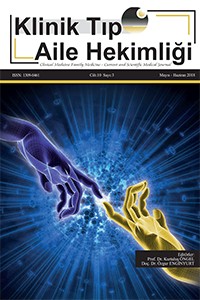Abstract
Abstract
Hypophyseal gigantism is a rare disease that develops due to the secretion of growthhormone in excess of the pituitary before epiphyseal plaques are closed, leading to a rapid and extreme height extension. In this case report, a patient was diagnosed with ahypophyseal gigantism who was suspected and investigated physical characteristics ofa 15 year old male patient who came to Ordu University Training and Research Hospital Family Medicine Polyclinic to receive a medical report to play volleyball. In this case,it was tried to draw attention to the fact that different patient groups could apply to Fa-mily Medicine polyclinics.
References
- Kaynaklar 1. Eugster EA, Pescovitz OH. Gigantism. J Clin Endocrinol Me-tab 1999; 84: 4379-84. 2. Epstein LH, Wing RR, Valoski A. Childhood obesity. PediatrClin North Am 1985; 32:363-79. 3. Whitehead EM, Shalet SM, Davies D, Enoch BA, Price DA,Beardwell CG. Pituitary gigantism: a disabling condition. ClinEndocrinol (Oxf) 1982; 17: 271-7. 4. Backeljauw PF, Dattani MT, Cohen P, Rosenfeld RG. Disor-ders of growth hormone/insulin-like growth factor secretionand action. In: Sperling MA (ed). Pediatric endocrinology. Ed4. Philadelphia, Saunders, pp 382-384. 5. Katznelson L, Atkinson JL, Cook DM, Ezzat SZ, HamrahianAH, Miller KK; AACE Acromegaly Task Force. American As-sociation of Clinical Endocrinologists Medical Guidelines forClinical Practice for the Diagnosis and Treatment of Acro-megaly--2011 update: executive summary. Endocr Pract2011; 17: 636-46. 6. Barkan AL, Beitins IZ, Kelch RP. Plasma insulin-like growthfactor-I/somatomedin-C in acromegaly: correlation with thedegree of growth hormone hypersecretion. J Clin EndocrinolMetab 1988; 67: 69-73. 7. Riedl S, Frisch H. Diagnosis of growth hormone excess andhyperprolactinemia. In: Ranke MB, Mullis P-E (eds). Diag-nostics of endocrine function in children and adolescents. ed4. Basel, Karger, 2011, pp 183–193. 8. Rhee N, Jeong K, Yang EM, Kim CJ. Gigantism caused bygrowth hormone secreting pituitary adenoma. Ann Pediatr En-docrinol Metab 2014; 19: 96-9. 9. Melmed S, Jackson I, Kleinberg D, Klibanski A. Current tre-atment guidelines for acromegaly. J Clin Endocrinol Metab1998; 83: 2646-52. 10. Abe T, Tara LA, Lüdecke DK. Growth hormone-secreting pi-tuitary adenomas in childhood and adolescence: features andresults of transnasal surgery. Neurosurgery 1999; 45: 1-10. 11. Andersen M. Management of endocrine disease: GH excess:diagnosis and medical therapy. Eur J Endocrinol 2013; 29:170:R31-41. 12. Vance ML. Pituitary adenoma: a clinician's perspective. En-docr Pract 2008; 14: 757-63. 13. Costin G. Endocrine disorders associated with tumors of thepituitary and hypothalamus. Pediatr Clin North Am 1979; 26:15-31.
Abstract
Öz
Hipofizer gigantizm epifizyal plaklar kapanmadan önce hipofizden fazla miktarda büyüme hormonu salgılanmasına bağlı olarak gelişen, hızlı ve aşırı bir boy uzamasına yolaçan nadir bir hastalıktır.Bu olgu sunumunda, Ordu Üniversitesi Eğitim ve Araştırma Hastanesi Aile Hekimliği polikliniğine voleybol oynamak için sağlık raporu almaya gelen 15 yaşındaki erkek hastanın fiziki özelliklerinden şüphelenilmesi ve araştırılması sonucu hipofizer gigantizm tanısı alan bir hasta tartışılmıştır.Bu vaka ile Aile Hekimliği polikliniklerine farklı hasta gruplarının başvurabileceğine dikkat çekilmeye çalışılmıştır.
References
- Kaynaklar 1. Eugster EA, Pescovitz OH. Gigantism. J Clin Endocrinol Me-tab 1999; 84: 4379-84. 2. Epstein LH, Wing RR, Valoski A. Childhood obesity. PediatrClin North Am 1985; 32:363-79. 3. Whitehead EM, Shalet SM, Davies D, Enoch BA, Price DA,Beardwell CG. Pituitary gigantism: a disabling condition. ClinEndocrinol (Oxf) 1982; 17: 271-7. 4. Backeljauw PF, Dattani MT, Cohen P, Rosenfeld RG. Disor-ders of growth hormone/insulin-like growth factor secretionand action. In: Sperling MA (ed). Pediatric endocrinology. Ed4. Philadelphia, Saunders, pp 382-384. 5. Katznelson L, Atkinson JL, Cook DM, Ezzat SZ, HamrahianAH, Miller KK; AACE Acromegaly Task Force. American As-sociation of Clinical Endocrinologists Medical Guidelines forClinical Practice for the Diagnosis and Treatment of Acro-megaly--2011 update: executive summary. Endocr Pract2011; 17: 636-46. 6. Barkan AL, Beitins IZ, Kelch RP. Plasma insulin-like growthfactor-I/somatomedin-C in acromegaly: correlation with thedegree of growth hormone hypersecretion. J Clin EndocrinolMetab 1988; 67: 69-73. 7. Riedl S, Frisch H. Diagnosis of growth hormone excess andhyperprolactinemia. In: Ranke MB, Mullis P-E (eds). Diag-nostics of endocrine function in children and adolescents. ed4. Basel, Karger, 2011, pp 183–193. 8. Rhee N, Jeong K, Yang EM, Kim CJ. Gigantism caused bygrowth hormone secreting pituitary adenoma. Ann Pediatr En-docrinol Metab 2014; 19: 96-9. 9. Melmed S, Jackson I, Kleinberg D, Klibanski A. Current tre-atment guidelines for acromegaly. J Clin Endocrinol Metab1998; 83: 2646-52. 10. Abe T, Tara LA, Lüdecke DK. Growth hormone-secreting pi-tuitary adenomas in childhood and adolescence: features andresults of transnasal surgery. Neurosurgery 1999; 45: 1-10. 11. Andersen M. Management of endocrine disease: GH excess:diagnosis and medical therapy. Eur J Endocrinol 2013; 29:170:R31-41. 12. Vance ML. Pituitary adenoma: a clinician's perspective. En-docr Pract 2008; 14: 757-63. 13. Costin G. Endocrine disorders associated with tumors of thepituitary and hypothalamus. Pediatr Clin North Am 1979; 26:15-31.
Details
| Primary Language | Turkish |
|---|---|
| Subjects | Internal Diseases |
| Journal Section | makaleler |
| Authors | |
| Publication Date | May 26, 2018 |
| Published in Issue | Year 2018 Volume: 10 Issue: 3 |


